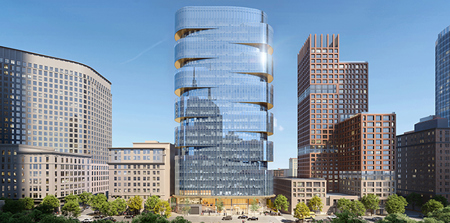

Three Eighty Stuart
CBT Architects
One of Boston’s first all-electric buildings, its design prioritizes carbon reduction through the entire design process, deploying the latest life cycle analysis tools and technologies to inform decision-making and promote conservation. Nestled in Boston’s famous Back Bay neighborhood, the design promotes connectivity and inclusivity, improving public access and circulation along every edge of the building. Establishing a new through-block passage and public open space with universally accessible social areas on the building's ground floor contributes to a safer and more inviting urban ecosystem. The double-height glass lobby offers a transparent and engaging street presence, connecting an expansive 7,700-square-foot pedestrian plaza to spacious interiors and retail. New multimodal connections, including a covered bike/walking path and a new pocket park, create a porous ground plane that invites the community to engage within and throughout the site. The design advances conventional sustainability models by integrating environmental and health considerations in the earliest phases. Careful evaluation of architectural features at every scale—from façade details to structural composition—and their impact on tenant health and the natural environment informs the overall form and design. This holistic approach leads to a significantly reduced carbon footprint and a healthy and productive office environment. Its curvilinear form and offset tiers create valuable opportunities for creating a healthy, equitable environment—most notably in the form of twenty-two equally distributed tenant terraces that provide direct outdoor access on nearly every level. Inside, reimagined common spaces include a cascading social stair accessible to those on foot and wheels. To achieve this, designers tackled the bigger question of how to make the popular "social stair" work for all by collaborating with the team at The Center for Independent Living. Also, each floor features gender-inclusive restrooms and amenity areas are designed to accommodate pop-up services. Focused on enhancing environmental benefits while providing healthy, comfortable office spaces for employees, the building's flexible floorplates, natural light, and outdoor access contribute to a successful and productive workplace. Featuring: • An efficient exterior wall core depth accommodates flexible furniture; • Increased window head height maximizes daylight while providing self-controlled glare protection; • 100% outside air ventilation with MERV 15 filtration increases comfort; • A high-performing façade allows for thermal comfort and resilient shelter-in-place opportunities; • A chilled-beam system manages temperature and humidity within indoor spaces. Throughout, designers used in-depth analyses to identify embodied carbon reduction opportunities, demonstrating how deliberate design decisions can optimize building performance at every scale. The designers simulated and tested scenarios in a digital model to measure the impact on the carbon footprint, leading to design modifications from the replacement of a window mullion with a simple fret, resulting in a 13% carbon reduction, to the use of less carbon-intense materials, targeting a 15–20% reduction in embodied carbon. Together, these project-wide modifications reduce embodied carbon dramatically compared to traditional approaches like material replacement.